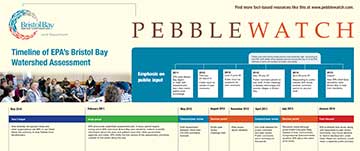
Over the course of three years preparing the Bristol Bay Watershed Assessment, the EPA has consulted more than 700 scientific sources, received more than 1 million comments and visited the Bristol Bay a number of times. Its major findings do not differ significantly between its first draft and its final: the agency predicts that significant direct impacts to fish-bearing streams are inevitable if a large-scale mine is developed in the area of the Pebble deposit, and devastating effects to aquatic life and habitat would occur if the mine’s tailings facility were to fail.
In the Bristol Bay Watershed Assessment, EPA describes the Bristol Bay watershed and its resources, and then assesses direct and indirect results of large-scale mining at the Pebble deposit. This risk assessment addresses a range of mining scenarios, based on Northern Dynasty Minerals’ 2011 Preliminary Assessment, which described for its investors mining scenarios for 20, 25 and 78 years of mining. The largest scenario EPA considers is based on extracting 6.5 billion tons of ore. However, the Pebble deposit contains an estimated 11.9 billion tons of ore. EPA notes that “were a mine to be developed that fully extracted this amount of ore, potential effects could be significantly greater than those estimated in the assessment.”
Major findings
- Inevitable effects
- Even operating on a day-to-day basis, a large-scale mine would impact between 24 and 94 miles of fish-bearing streams, and would eliminate up to 5,350 acres of wetlands, ponds and lakes.
- Up to 33 additional miles of salmon-bearing streams would be affected by altered streamflows.
- Effects in case of failure
- Partial tailings dam failure: catastrophic effects
- Transportation corridor: crosses 55 known salmon-bearing streams; culverrt failures, runoff or spills would put salmon-spawning areas at risk
- Wastewater treatment plant failure: direct and indirect adverse effects on fish in up to 62 miles of stream
- Pipeline: could release toxic copper concentrate or diesel fuel into salmon-supporting streams and wetlands
How the document has changed
During the course of its assessment development, additional studies became available to the EPA, including the “Environmental Baseline Document” published by the Pebble Limited Partnership in early 2012. While major findings did not change significantly between drafts, the EPA did respond to public and peer review comments to reorganize information and include detail in some sections. For example, the agency expanded its description of compensatory mitigation options in Appendix J in response to several requests for this information. EPA has published a comment-by-comment response to suggestions made by its independent peer review team and is currently preparing a similar document that will detail its responses to more than 5,000 public comments.
EPA Watershed Assessment Timeline – A Pebble Watch graphic
EPA Watershed Assessment
Response to peer review comments
Pebble Watch Summaries
Final version (coming soon)
